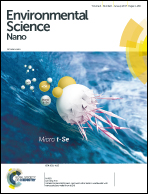Synthesis of CuxNi(1−x)O coral-like nanostructures and their application in the design of a reusable toxic heavy metal ion sensor based on an adsorption-mediated electrochemical technique†
Abstract
Nickel oxide, and non-stoichiometric and Cu-doped variants (NiO, Ni2O3 and CuxNi(1−x)O) possessing porous coral-like nanostructures, were prepared by a facile, low temperature, hydrothermal approach. Structural and morphological characterization was performed by X-ray diffractometry, X-ray photoelectron spectroscopy and FESEM imaging. The Cu-doped oxide was found to possess lattice strain which resulted in the induction of surface defects. The prepared materials were used as sensing materials for toxic Cr(VI) ions in aqueous medium. A novel sensing technique was proposed based on adsorption, which was found to be more effective in terms of reproducibility and reusability of the sensor than the conventional electrochemical sensing technique. The sensing mechanism was explained based on the phenomenon of adsorption. This makes the efficiency of the sensor surface-dependent rather than chemical reactivity-dependent, thereby making it a non-destructive sensing technique. The Cu-doped NiO nanostructure (10% Cu doping) was found to show maximum sensitivity (252.62 at 1 ppm) and high selectivity, together with a low response time (∼2 s), towards Cr(VI) ions relative to Cd(II), As(V) and Pb(II) ions. This was due to its enhanced surface properties compared with its un-doped variants. The effect of Cu doping on the nanostructure morphology and consequently on sensor efficiency was also studied. The limit of detection was found to be 1 ppm (1 mg L−1) of Cr(VI) ions in aqueous solution. This material, along with the technique proposed, can thus be advantageous for the cost-efficient monitoring of water quality and drinking water standards.


 Please wait while we load your content...
Please wait while we load your content...